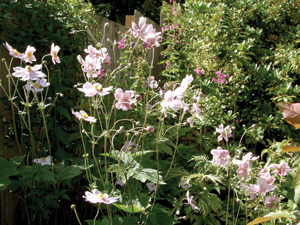
Before I was introduced to Japanese anemones more than a decade ago, I always associated anemones with spring and the brightly colored varieties that appear in the garden just after winter. The Japanese anemone (Anemone X hybrida), which actually originated in China but was discovered in Japan in the late 17th century (hence the name) is a late-blooming variety of anemone that gracefully appears in the garden in early fall. The flowers are poppy-like in appearance and bloom atop long, elegant stems that can grow anywhere between 2 and 5 feet high. When in full bloom, these lovely flowers lend a breath of fresh air to tired fall gardens. Sometimes referred to as wind flowers, since the word anemone is Greek for wind, these plants are long-lived, tuberous-rooted perennials that come in shades of pure white, pale pink and tones of pink that range all the way to deep rosy pink. The most common varieties have single petals, but several hybrids sport double petals. The flower’s center stamen and pistils are bright golden yellow, a striking contrast to the flower’s pale and pastel petals. The plant’s long stems may look delicate but are actually quite strong and do not need to be staked. During the spring and summer months, the foliage is an attractive addition to the garden, and in the fall the plant’s glossy green leaves turn a reddish hue. Japanese anemones are easy to grow, since they tolerate most soil types and are virtually pest free, but you do need to bait for slugs and snails. While they can be grown in most soils, they do prefer soils with good drainage and organic matter. They thrive in areas with partial shade and can tolerate more sun along the coast. During hot, dry months they require frequent watering, but if they’re kept well mulched the water requirement will be less. Choose an area in your garden where your Japanese anemones can spread out over time, since they can become quite invasive. While these plants may take a year or two to establish, once they become happily ensconced in your garden, they will begin to spread out quite readily. These plants are particularly attractive when planted in a large cluster, and, in time, one or two plants will become a large drift of fall flowers. When you are ready to plant your Japanese anemone, dig a hole the depth of the pot the plant is growing in. Most of the plants I have seen at local garden centers are in 1-gallon pots. Carefully plant them, taking care not to disturb their delicate root ball. After planting, add some organic compost or mulch to the top of the soil. In the winter, after the flowers have faded, cut the plants down to the ground. I usually cover the area with organic compost in January, when I begin my spring planting, but remember to be careful not to disturb the plant’s roots as you plant around it. Once established, you can divide your plants in the winter after they finish blooming, and after a few years, you will have enough plants to share with your friends and neighbors. — Linda is a local Realtor with Coldwell Banker who specializes in historic and architecturally designed homes. Take a tour of Linda’s garden on www.LindaMarrone.com.












Discussion about this post